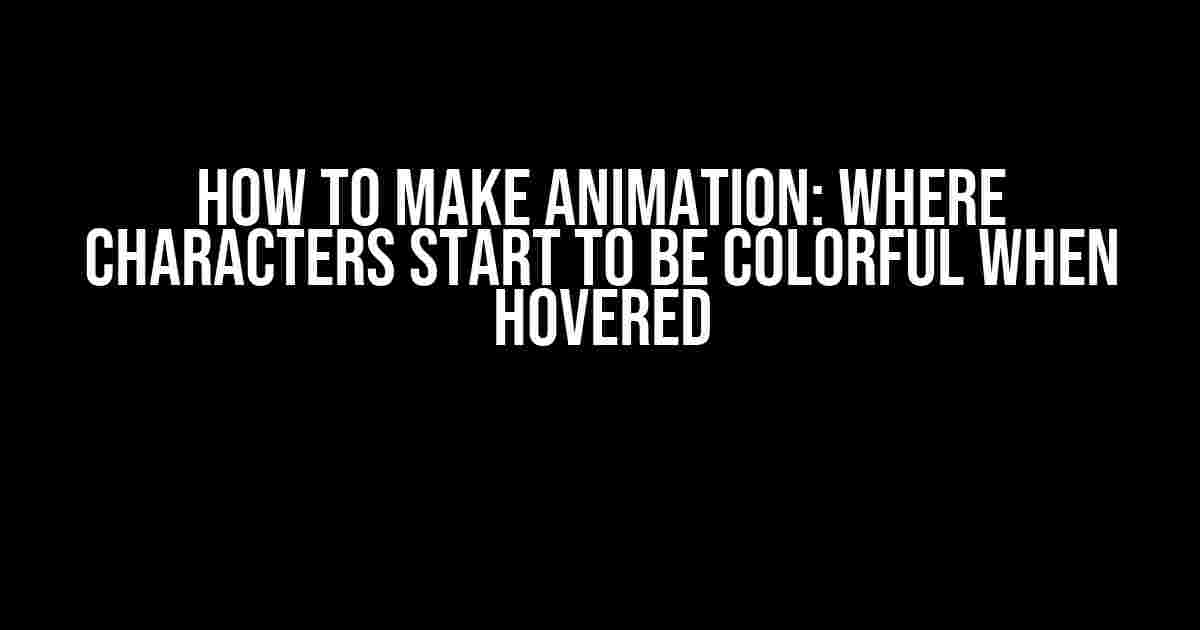Are you tired of plain and dull character animations? Want to add a pop of color and excitement to your website or app? Look no further! In this comprehensive guide, we’ll show you how to create an animation where characters start to be colorful when hovered. This effect is perfect for interactive storytelling, gamification, or simply adding a touch of personality to your design.
What You’ll Need
To get started, you’ll need:
- A basic understanding of HTML, CSS, and JavaScript
- A code editor or IDE (such as Visual Studio Code or Sublime Text)
- A browser that supports CSS animations (such as Google Chrome or Mozilla Firefox)
- A character or object that you want to animate (such as a SVG or PNG image)
Step 1: Prepare Your Character
Before we dive into the animation, let’s prepare your character. If you haven’t already, create a new file for your character in your preferred format (such as SVG or PNG). For this example, we’ll use a simple SVG cat icon.
<svg width="100" height="100">
<g>
<circle cx="50" cy="50" r="40" fill="#fff" />
<circle cx="50" cy="50" r="30" fill="#000" />
</g>
</svg>
Step 2: Add Basic Styles
In your CSS file, add the following basic styles to position and color your character:
.character {
position: absolute;
top: 50%;
left: 50%;
transform: translate(-50%, -50%);
width: 100px;
height: 100px;
fill: #fff;
stroke: #000;
stroke-width: 2;
}
Step 3: Create a Hover Effect
To create the hover effect, we’ll use CSS pseudoclasses. Add the following code to your CSS file:
.character:hover {
fill: #ffd700; /* Change the fill color to yellow on hover */
stroke: #ff69b4; /* Change the stroke color to pink on hover */
}
Step 4: Add Animation
To add animation to your hover effect, we’ll use CSS keyframe animations. Add the following code to your CSS file:
.character:hover {
animation: colorChange 0.5s forwards;
}
@keyframes colorChange {
0% {
fill: #fff;
stroke: #000;
}
100% {
fill: #ffd700;
stroke: #ff69b4;
}
}
Step 5: Add a Colorful Twist
To make our animation more interesting, let’s add a colorful twist. We’ll use CSS gradients to create a rainbow effect on hover.
.character:hover {
animation: colorChange 0.5s forwards;
background-image: linear-gradient(to bottom, #ffd700, #ff69b4, #fc9800, #009688, #4caf50);
background-size: 100% 100%;
background-position: 0% 100%;
}
@keyframes colorChange {
0% {
fill: #fff;
stroke: #000;
background-position: 0% 100%;
}
100% {
fill: #ffd700;
stroke: #ff69b4;
background-position: 100% 100%;
}
}
Step 6: Put it All Together
Now that we have our animation and hover effect set up, let’s put it all together. Create a new HTML file and add the following code:
<div class="character">
<svg width="100" height="100">
<g>
<circle cx="50" cy="50" r="40" fill="#fff" />
<circle cx="50" cy="50" r="30" fill="#000" />
</g>
</svg>
</div>
Result
Open your HTML file in a browser and hover over the character. You should see a colorful animation where the character’s fill and stroke colors change on hover.
| Before Hover | On Hover |
|---|---|
Tips and Variations
Want to take your animation to the next level? Here are some tips and variations:
-
Use Different Shapes
Instead of a circle, try using different shapes like squares, triangles, or polygons.
-
Experiment with Gradients
Try using different gradient types, such as radial gradients or repeating gradients, to create unique effects.
-
Add Multiple Animations
Use JavaScript to trigger multiple animations on hover, creating a more complex and engaging effect.
-
Make it Interactive
Use JavaScript to make the animation interactive, allowing users to click or drag the character to change its behavior.
Conclusion
In this article, we’ve shown you how to create a colorful animation where characters start to be colorful when hovered. With these simple steps, you can add a touch of personality to your design and make your website or app more engaging. Remember to experiment with different shapes, gradients, and animations to create unique effects that will leave your users in awe.
Happy coding!
Note: The code provided is for demonstration purposes only and may require modifications to work in your specific project. Make sure to test and adjust the code according to your needs.
Frequently Asked Question
Get ready to inject some magic into your animation! Here are the most frequently asked questions on how to make characters burst with color when you hover over them.
What software do I need to create colorful hover effects?
You can use a combination of graphic design and animation software like Adobe Animate, Adobe After Effects, or Blender. For web development, you’ll need HTML, CSS, and JavaScript coding skills. Don’t worry, we’ll break it down into simple steps!
How do I design colorful characters for my animation?
Create your characters in a vector graphics editor like Adobe Illustrator or Inkscape. Use bold lines, vibrant colors, and playful textures to bring your characters to life. Make sure to save them as SVG files for easy integration into your animation software.
What’s the best way to create a hover effect in CSS?
Use the `:hover` pseudo-class to target your character’s SVG element. Then, add CSS transitions to smoothly change the fill color, stroke, or opacity when the user hovers over the character. For example: `.character:hover { fill: #FF69B4; transition: fill 0.5s; }`.
Can I add animation to my hover effect?
Absolutely! Use JavaScript libraries like AnimeJS or GSAP to create animations that respond to hover events. You can also use CSS keyframe animations or SMIL animations in your SVG files. Get creative and experiment with different animation styles to make your characters truly pop!
How do I optimize my colorful hover effect for web performance?
Use CSS sprites or icon fonts to reduce the number of HTTP requests. Optimize your SVG files by compressing them and removing unnecessary code. Finally, use CSS will-change or JavaScript to trigger animations only when necessary, ensuring a smooth user experience.
